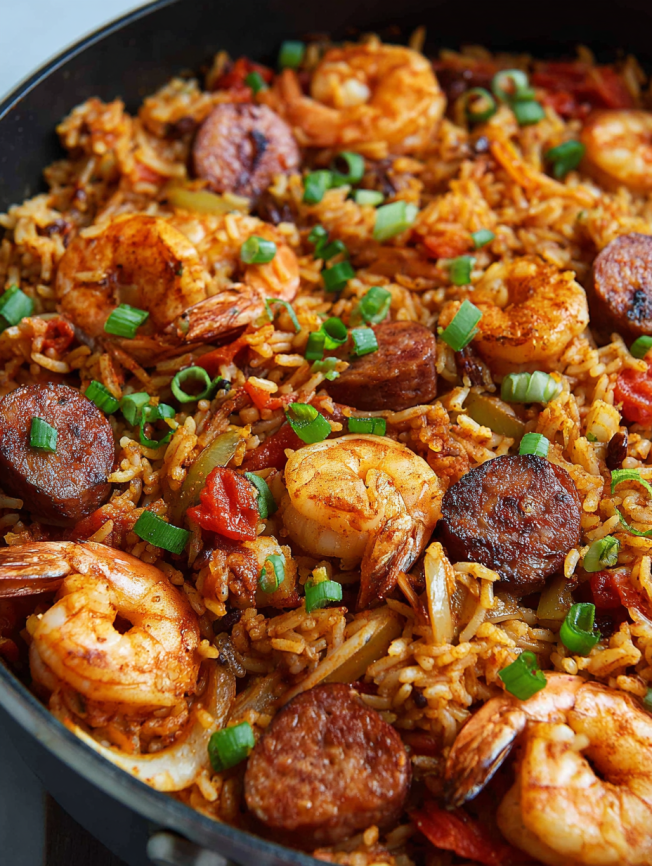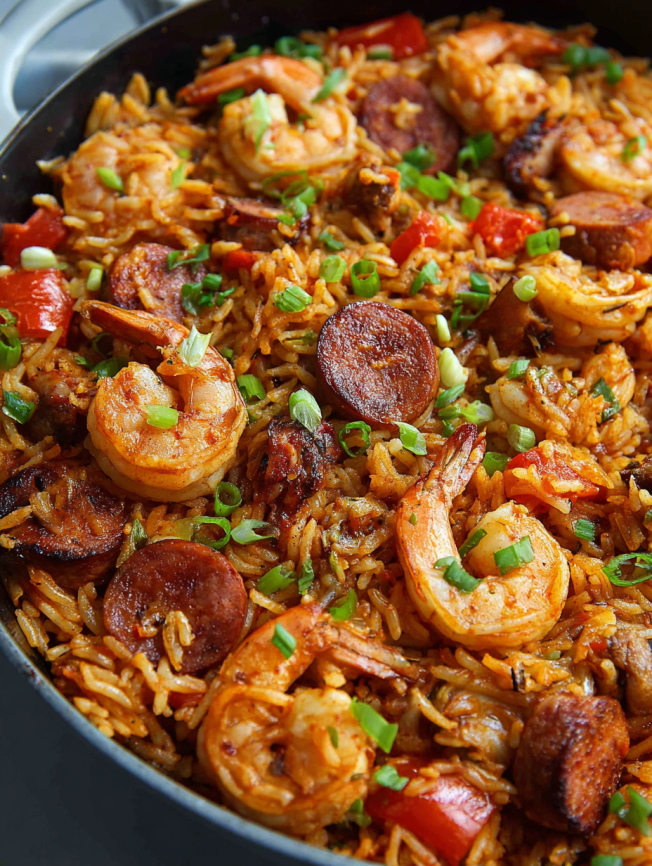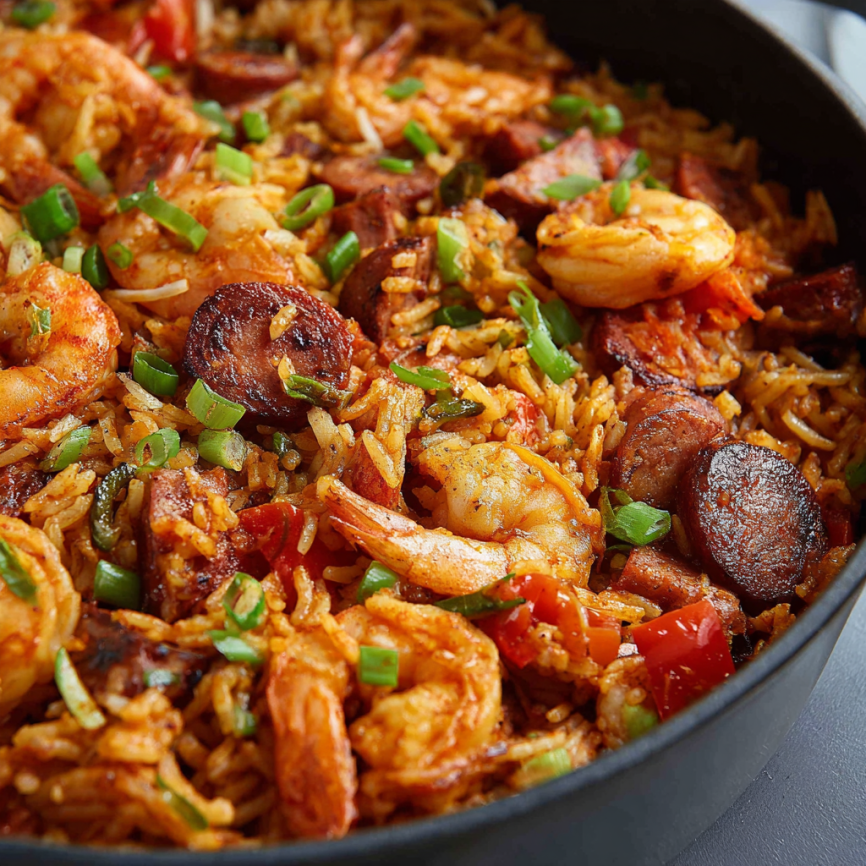Growing up, my grandmother would fill the house with the most incredible aromas every Sunday afternoon. Her jambalaya wasn’t just a meal—it was a celebration, a gathering point that brought our entire family together around one steaming pot. Years later, after countless attempts to recreate her magic, I finally perfected this authentic jambalaya recipe that captures all the soul and flavor of New Orleans in every single bite.
This isn’t just any jambalaya; it’s the real deal. With perfectly seasoned chicken, succulent shrimp, and smoky sausage all nestled in a bed of fluffy, flavor-packed rice, this dish embodies the true spirit of Creole cooking. What makes this recipe special is the careful layering of flavors—each ingredient builds upon the last, creating a symphony of taste that’s both comforting and exciting.
Why This Jambalaya Will Become Your New Favorite
Authentic Cajun Heritage: This recipe follows traditional New Orleans techniques, ensuring you get that genuine Creole flavor profile. Furthermore, the careful balance of the “Holy Trinity” (onions, celery, and bell peppers) provides the authentic foundation that makes jambalaya so distinctive.
One-Pot Wonder: Everything cooks in a single pot, which means minimal cleanup and maximum flavor development. Additionally, this cooking method allows all the ingredients to meld together beautifully, creating layers of taste that you simply can’t achieve with separate cooking methods.
Protein Powerhouse: With chicken, shrimp, and sausage, this dish delivers substantial protein that satisfies even the heartiest appetites. Moreover, the combination of these three proteins creates a complex, rich flavor that’s absolutely irresistible.
Perfect for Entertaining: This recipe easily feeds a crowd and actually tastes better when made in larger quantities. Even better, it’s forgiving enough for novice cooks while impressive enough for special occasions.
Budget-Friendly Luxury: Despite tasting like an expensive restaurant dish, jambalaya uses affordable ingredients and creates multiple generous servings, making it perfect for family meals.
Essential Ingredients for Authentic Flavor
The Protein Trinity
- 1 lb boneless chicken, diced into bite-sized pieces
- 9-10 large shrimp, peeled and deveined
- 10 ounces smoked sausage (andouille preferred), sliced
The Flavor Foundation
- 2 cups long-grain white rice, washed and uncooked
- 1 large onion, chopped
- 2 ribs celery, chopped
- 2 green onions, chopped (for garnish)
- 3-4 cloves garlic, minced
The Tomato Base
- 1 can (14-15 oz) crushed tomatoes
- 2 tablespoons tomato paste
The Cajun Spice Blend
- 2 tablespoons Cajun seasoning
- 1 teaspoon dried thyme
- 1 teaspoon oregano
- Salt and black pepper to taste
The Liquid Gold
- 3-4 cups low-sodium chicken or vegetable broth
- Cooking oil for sautéing
Step-by-Step Jambalaya Mastery
Creating the Perfect Spice Mix
Step 1: In a small bowl, combine Cajun seasoning, dried thyme, oregano, salt, and black pepper. This aromatic blend will be the flavor backbone of your entire dish.
Seasoning the Stars
Step 2: Place the diced chicken in a medium bowl and toss with ½ tablespoon of your spice mixture. Allow the chicken to marinate while you prepare the other ingredients—this extra time helps the flavors penetrate the meat.
Step 3: In a separate bowl, gently toss the shrimp with 1 teaspoon of the spice blend. Reserve the remaining seasoning for the rice cooking process.
Building Layers of Flavor
Cooking the Proteins
Step 4: Heat 3 tablespoons of oil in a large, heavy-bottomed pot or Dutch oven over medium heat. Once the oil shimmers, add the seasoned chicken pieces in a single layer. Cook for 3-4 minutes per side until golden brown and cooked through. Transfer to a plate and set aside.
Step 5: Using the same pot (don’t clean it—those browned bits are pure flavor!), add a touch more oil if needed. Sear the seasoned shrimp for approximately 2 minutes per side until pink and cooked through. Remove and place on the same plate as the chicken.
Step 6: Add 1 tablespoon of oil to the pot and sauté the sliced sausage for several minutes until beautifully browned on both sides. The sausage will release its smoky flavors into the oil, creating an incredible base. Remove and set aside with the other proteins.
Creating the Aromatic Base
Step 7: Add 4-5 tablespoons of oil to the same pot, ensuring you scrape up any delicious browned bits from the bottom. Sauté the chopped onion and minced garlic over medium heat until fragrant and translucent, about 1-2 minutes.
Step 8: Stir in the tomato paste and crushed tomatoes. Cook this mixture for 3-4 minutes, stirring occasionally, until some of the liquid evaporates. This crucial step concentrates the tomato flavors and prevents the rice from becoming mushy later.
The Rice Magic
Step 9: Add the remaining spice mixture, washed rice, chopped celery, and chicken broth to the pot. Stir everything together, ensuring the rice is evenly distributed and coated with the flavorful tomato mixture.
Step 10: Bring the mixture to a gentle boil, then reduce heat to medium-low. Cover the pot and simmer for 15-20 minutes, stirring occasionally to prevent the rice from sticking to the bottom.
Step 11: Check the rice periodically—it should be tender and fluffy when done. If needed, add additional broth or water, ¼ cup at a time, until the rice reaches the perfect consistency.
The Grand Finale
Step 12: Once the rice is perfectly cooked, gently fold in the reserved chicken, shrimp, and sausage. Stir carefully to distribute the proteins evenly without breaking up the rice grains.
Step 13: Remove from heat and let stand for 5 minutes to allow all flavors to meld together. Garnish generously with chopped green onions before serving.

Serving Suggestions
Jambalaya is traditionally served as a complete meal on its own, but certain accompaniments can elevate the experience even further. Consider serving it with a simple side salad dressed with a light vinaigrette to cut through the richness of the dish.
Warm, crusty French bread or cornbread makes an excellent addition, perfect for soaking up any extra flavorful liquid. Additionally, a cold beer or a glass of crisp white wine complements the spicy, smoky flavors beautifully.
For a true New Orleans experience, serve your jambalaya with a side of creamy coleslaw and some pickled okra or jalapeños for extra tang and crunch.
Creative Recipe Variations
Seafood Lover’s Version
Replace the chicken with additional shrimp, crab meat, or oysters for a luxurious seafood jambalaya. Add the delicate seafood during the last 5 minutes of cooking to prevent overcooking.
Vegetarian Twist
Substitute the proteins with a combination of mushrooms, bell peppers, and plant-based sausage. Increase the vegetables and use vegetable broth for a satisfying meatless version.
Turkey and Ham Holiday Special
Use leftover holiday turkey and ham instead of chicken and sausage. This variation is perfect for transforming holiday leftovers into something exciting and new.
Spice Level Adjustments
For milder palates, reduce the Cajun seasoning and omit any additional hot sauce. Conversely, heat lovers can add cayenne pepper, hot sauce, or fresh jalapeños to kick up the spice level.
Make-Ahead and Storage Tips
While jambalaya tastes best when served fresh, you can prepare several components ahead of time. Season the proteins up to 24 hours in advance and store them covered in the refrigerator—this actually improves the flavor as the spices have more time to penetrate.
You can also prepare the spice blend and chop all vegetables the day before. Store the spice mixture in an airtight container and keep prepped vegetables in separate containers in the refrigerator.
Leftover jambalaya keeps well in the refrigerator for up to 3 days. When reheating, add a splash of broth to restore moisture and heat gently to avoid overcooking the proteins.
Professional Cooking Notes
Rice Selection: Long-grain white rice is essential for authentic jambalaya. Short-grain rice becomes too sticky, while brown rice requires different cooking times and liquid ratios.
Liquid Management: The key to perfect jambalaya is achieving the right rice-to-liquid ratio. Start with less broth than you think you need—you can always add more, but you can’t take it away.
Temperature Control: Maintain medium heat throughout the cooking process. High heat will cause the bottom to burn before the rice cooks through, while low heat won’t develop proper flavors.
Sausage Selection: Authentic andouille sausage provides the best flavor, but any good-quality smoked sausage works well. Avoid overly fatty sausages that might make the dish greasy.

Frequently Asked Questions
Q: Can I use brown rice instead of white rice? A: While possible, brown rice requires significantly more liquid and cooking time (45-50 minutes instead of 15-20). Additionally, the texture and flavor won’t be as authentic to traditional jambalaya.
Q: My rice turned out mushy. What went wrong? A: Mushy rice usually results from too much liquid or overcooking. Make sure to cook the tomato mixture long enough to evaporate excess moisture, and avoid stirring the rice too frequently once it’s cooking.
Q: Can I make this dish in a rice cooker? A: While not traditional, you can adapt this recipe for a rice cooker. Sauté all ingredients except the rice and broth in a separate pan first, then transfer everything to the rice cooker with the appropriate amount of liquid.
Q: What’s the best way to prevent the rice from sticking? A: Use a heavy-bottomed pot, maintain proper heat levels, and stir occasionally but not constantly. Also, make sure to scrape up any browned bits from the bottom when building your base.
Q: Can I freeze leftover jambalaya? A: Yes, jambalaya freezes well for up to 3 months. However, the rice texture may change slightly upon thawing. Thaw overnight in the refrigerator and reheat gently with a splash of broth.
Q: How do I know when the jambalaya is done? A: The rice should be tender and have absorbed most of the liquid, but the dish shouldn’t be completely dry. There should be just enough moisture to keep everything cohesive without being soupy.
Q: Can I add vegetables like bell peppers? A: Absolutely! Bell peppers are actually part of the traditional “Holy Trinity” in Creole cooking. Add them with the onions and celery for authentic flavor.
Recipe Details:
- Course: Main Course, Dinner, Lunch, One-Pot Recipe
- Cuisine: American (New Orleans/Creole)
- Prep Time: 20 minutes
- Cook Time: 30 minutes
- Total Time: 50 minutes
- Servings: 4 generous portions
- Calories: 588 per serving
Nutritional Information: Calories: 588 | Carbohydrates: 91g | Protein: 50g | Fat: 24g | Fiber: 6g | Sodium: 1488mg | Potassium: 1395mg | Vitamin A: 2326IU | Iron: 5mg

